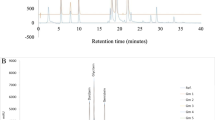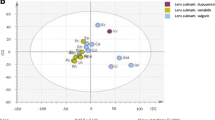Abstract
A high-performance liquid chromatography method coupled with mass spectrometry and chemometric analysis has been developed for the quality evaluation of wild and cultivated soybean as well as bean products. Fifteen isoflavones were qualified by LC–MS and quantified by HPLC. The assay results demonstrated that the type of isoflavones was quite similar between cultivated and wild soybean, and 6″-O-malonylglucosides were the main ingredients in soybean, while glucosides and aglycones were abundant in bean products. Moreover, the unsupervised chemometric methods including principal component analysis (PCA) and cluster analysis revealed that different species, geographic locations, and the processing methods have great influences on the chemical properties of soybean and bean products. In conclusion, HPLC coupled with chemometric techniques would be a very flexible and reliable method for dietary selection of soybean and bean products.





Similar content being viewed by others
References
Wang KJ, Yamashita T, Watanabe M, Takahata Y (2004) Genetic characterization of a novel Tib-derived variant of soybean Kunitz trypsin inhibitor detected in wild soybean (Glycine soja). Genome 47:9–14
Fukuda T, Maruyama N, Kanazawa A, Abe J, Shimamoto Y, Hiemori M, Tsuji H, Tanisaka T, Utsumi S (2005) Molecular analysis and physicochemical properties of electrophoretic variants of wild soybean Glycine soja storage proteins. J Agric Food Chem 53:3658–3665
Pizzutti IR, de Kok A, Zanella R, Adaime MB, Hiemstra M, Wickert C, Prestes OD (2007) Method validation for the analysis of 169 pesticides in soya grain, without clean up, by liquid chromatography–tandem mass spectrometry using positive and negative electrospray ionization. J Chromatogr A 1142:123–136
Kim JJ, Kim SY, Hahn SJ, Chung IM (2005) Changing soybean isoflavone composition and concentrations under two different storage conditions over 3 years. Food Res Int 38:435–444
Rostagno MA, Palma M, Barroso CG (2005) Solid-phase extraction of soy isoflavones. J Chromatogr A 1076:110–117
Ali AA, Velasquez MT, Hansen CT, Mohamed AI, Bhathena SJ (2004) Effects of soybean isoflavones, probiotics, and their interactions on lipid metabolism and endocrine system in an animal model of obesity and diabetes. J Nutr Biochem 15:583–590
Wang X, Ge X, Bai X, Song C, Niu L, Xu H (2003) Effects of Semen Sojae Preparatum on lipid metabolism in ovariectomized rat. Zhong Yao Cai 26:652–654
Thomas BF, Zeisel SH, Busby MG, Hill JM, Mitchell RA, Scheffler NM, Brown SS, Bloeden LT, Dix KJ, Jeffcoat AR (2001) Quantitative analysis of the principle soy isoflavones genistein, daidzein and glycitein, and their primary conjugated metabolites in human plasma and urine using reversed-phase high-performance liquid chromatography with ultraviolet detection. J Chromatogr B 760:191–205
Islam F, Sparkes C, Roodenrys S, Astheimer L (2008) Short-term changes in endogenous estrogen levels and consumption of soy isoflavones affect working and verbal memory in young adult females. Nutr Neurosci 11:251–262
Wu AH, Stanczyk FZ, Hendrich S, Murphy PA, Zhang C, Wan P, Pike MC (2000) Effects of soyfoods on ovarian function in premenopausal women. Brit J Cancer 82:1879–1886
Gu LW, Gu WY (2001) Characterisation of soy isoflavones and screening for novel malonyl glucosides using high-performance liquid chromatography-electrospray ionisation-mass spectrometry. Phytochem Anal 12:377–382
Lee YW, Kim JD, Zheng JZ, Row KH (2007) Comparisons of isoflavones from Korean to Chinese soybean and processed products. Biochem Eng J 36:49–53
Kim JA, Hong SB, Jung WS, Yu CY, Ma KH, Gwag JG, Chung IM (2007) Comparison of isoflavones composition in seed, embryo, cotyledon and seed coat of cooked-with-rice and vegetable soybean (Glycine max L.) varieties. Food Chem 102:738–744
Cavaliere C, Cucci F, Foglia P, Guarino C, Samperi R, Lagana A (2007) Flavonoid profile in soybeans by high-performance liquid chromatography/tandem mass spectrometry. Rapid Commun Mass Spectrom 21:2177–2187
Rostagno MA, Palma M, Barroso CG (2007) Fast analysis of soy isoflavones by high-performance liquid chromatography with monolithic columns. Anal Chim Acta 582:243–249
Dinelli G, Aloisio I, Bonetti A, Marotti I, Cifuentes A (2007) Compositional changes induced by UV-B radiation treatment of common bean and soybean seedlings monitored by capillary electrophoresis with diode array detection. J Sep Sci 30:604–611
Peng YY, Chu QC, Ye JN (2004) Determination of isoflavones in soy products by capillary electrophoresis with electrochemical detection. Food Chem 87:135–139
Sutil GA, Mandarino JM, Laurindo JB, Benassi V, Góes-Favoni S, Petrus JCC (2008) Effect of hydrothermal treatment and pH on the formation of aglycones in soybean. Eur Food Res Technol 227:1729–1731
Riedl KM, Lee JH, Renita M, St Martin SK, Schwartz SJ, Vodovotz Y (2007) Isoflavone profiles, phenol content, and antioxidant activity of soybean seeds as influenced by cultivar and growing location in Ohio. J Sci Food Agric 87:1197–1206
Lee SW, Lee JH (2009) Effects of oven-drying, roasting, and explosive puffing process on isoflavone distributions in soybeans. Food Chem 112:316–320
Escribano S, Sánchez FJ, Lázaro A (2010) Establishment of a sensory characterization protocol for melon (Cucumis melo L.) and its correlation with physical–chemical attributes: indications for future genetic improvements. Eur Food Res Technol 231:611–621
Thanaraj T, Terry LA, Bessant C (2009) Chemometric profiling of pre-climacteric Sri Lankan mango fruit (Mangifera indica L.). Food Chem 112:786–794
Wardhani DH, Vazquez JA, Pandiella SS (2008) Kinetics of daidzin and genistin transformations and water absorption during soybean soaking at different temperatures. Food Chem 111:13–19
Kudou S, Fleury Y, Welti D, Magnolato D, Uchida T, Kitamura K, Okubo K (1991) Malonyl isoflavone glucosides in soybean seeds (Glycine max Merrill). J Agric Food Chem 55:2227–2233
Barnes S, Kirk M, Coward L (1994) Isoflavones and their conjugates in soyfoods: extraction conditions and analysis by HPLC-mass spectrometry. J Agric Food Chem 42:2466–2474
Kao TH, Chen BH (2002) An improved method for determination of isoflavones in soybean powder by liquid chromatography. Chromatographia 56:423–430
Riedl KM, Lee JH, Renita M, Martin SK, Schwartz SJ, Vodovotz Y (2007) Isoflavone profiles, phenol content, and antioxidant activity of soybean seeds as influenced by cultivar and growing location in Ohio. J Sci Food Agr 87:1197–1206
Rostagno MA, Araujo JMA, Sandi D (2002) Supercritical fluid extraction of isoflavones from soybean flour. Food Chem 78:111–117
Coward L, Smith M, Kirk M, Barnes S (1998) Chemical modification of isoflavones in soyfoods during cooking and processing. Am J Clin Nutr 68:1486S–1491S
Kawakami Y, Tsurugasaki W, Nakamura S, Osada K (2005) Comparison of regulative functions between dietary soy isoflavones aglycone and glucoside on lipid metabolism in rats fed cholesterol. J Nutr Biochem 16:205–212
Coldham NG, Darby C, Hows M, King LJ, Zhang AQ, Sauer MJ (2002) Comparative metabolism of genistin by human and rat gut microflora: detection and identification of the end-products of metabolism. Xenobiotica 32:45–62
Marini H, Minutoli L, Polito F, Bitto A, Altavilla D, Atteritano M, Gaudio A, Mazzaferro S, Frisina A, Frisina N, Lubrano C, Bonaiuto M, D’Anna R, Cannata ML, Corrado F, Adamo EB, Wilson S, Squadrito F (2007) Effects of the phytoestrogen genistein on bone metabolism in osteopenic postmenopausal women: a randomized trial. Ann Intern Med 146:839–847
Acknowledgments
This research was financially supported by the Priority Academic Program Development of Jiangsu Higher Education Institutions (PAPD). The author greatly appreciates **ao-**ao Liu, Jie Yang, and Mei-Ting Ren for the technical help and experiment constructions.
Author information
Authors and Affiliations
Corresponding authors
Rights and permissions
About this article
Cite this article
Hong, JL., Qin, XY., Shu, P. et al. Comparative study of isoflavones in wild and cultivated soybeans as well as bean products by high-performance liquid chromatography coupled with mass spectrometry and chemometric techniques. Eur Food Res Technol 233, 869–880 (2011). https://doi.org/10.1007/s00217-011-1564-z
Received:
Revised:
Accepted:
Published:
Issue Date:
DOI: https://doi.org/10.1007/s00217-011-1564-z




